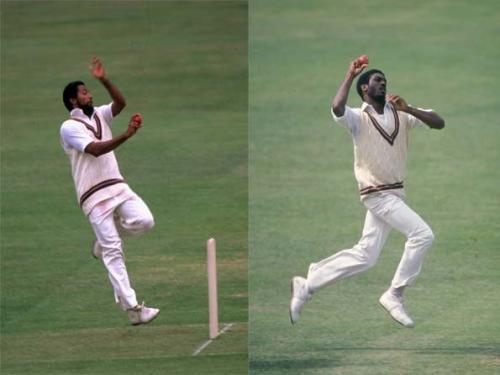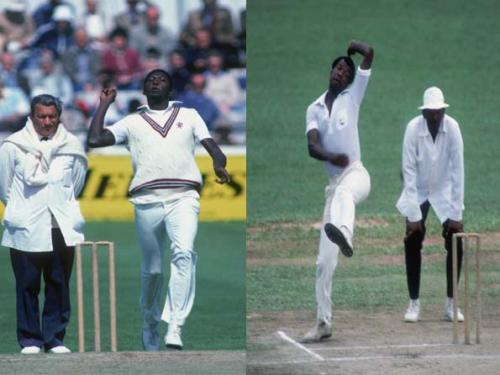‘Fire in Babylon’ releases in India today, a riveting behind-the-scenes look at the evolution of the West Indies cricket team into a fearsome superpower running on a battery of pace bowlers. Arunabha Sengupta turns a critical eye at the movie which shows some of the scariest spells of fast bowling.
There may be viewers who will detect some exaggerated racial overtones while dealing with West Indian cricket. There may be others who will find the story-telling a wee bit too one sided, too black and white.
Yet, if one is thrilled by the sight of superfast bowlers unleashing their menace at shivering batsmen, Fire in Babylon will keep him glued to the screen till the last ball is bowled.
Brithish filmmaker Stevan Riley, who previously covered the rivalry of the Oxford and Cambridge boxing teams in Blue Blood, combines a lot of interest-arousing elements into the history of West Indies emerging as a cricketing superpower in the 1970s and ‘80s.
It is a documentary combining ingredients of a political thriller, a historical drama, an action story of revenge and retribution, and even, in parts, a musical. And of course, there is cricket that runs through it, of the most exciting variety.
There is the portrayal of socio-political struggle for emancipation of the coloured people of the Caribbean islands that is conspicuously weaved into the theme. It is done through a crafty narration of the white occupation, the struggles of the black immigrants in United Kingdom and the liberating euphoria of beating the old masters at their own game. The clear message is that the West Indian dominance on the cricket field was much more than winning games.
There is historical narration of the turmoil of the seventies, with the Kerry Packer interlude, and the role it played in building West Indies into a fighting fit unit of superb athletes, sculpting the amateur brigade of fast bowlers into the cricketing equivalent of professional hit men.
Inserted as a crucial structure into the scheme of things is the engaging story of the underdog. It follows a bunch of young, innocent and talented individuals, with their happy go lucky ways of Calypso cricket. There follows the period when they are bullied through brutal hostility in the big bad nation Down Under.
Humiliated by the fiery pace of Dennis Lillee and Jeff Thomson, mentally wearied by the Chappell brothers and their band of rough men, they often break down in tears.
Close at hand is the leader in Clive Lloyd who pledges “never again” and builds a team running on a battery of fast bowlers. The heroes emerge – Viv Richards and Gordon Greenidge with the bat and Andy Roberts, Michael Holding, Joel Garner and Colin Croft with the ball – fresh faced youngsters forged by the circumstances into hardened warriors. Finally they get their revenge – over the rowdy Australians as well as their erstwhile colonial overlords England.
And then there is music. Fascinatingly integrated. From reggae and calypso, with Lord Short Shirt’s wacky ode to Viv Richards; to the politically stirring voice of Bob Marley singing, “Get up, stand up; stand up for your rights.”
Fascinating clips cricketing and otherwise
All the while the cricketers play their part. The interviews and clips – cricketing and otherwise – are built together into an intricate jigsaw, where almost everything falls into place. Clive Lloyd, Andy Roberts, Michael Holding, Colin Croft, Viv Richards and Greenidge speak about their experiences, interspersed with shots of cricketing action and commentary by social historians. And all the while we are treated to some jaw-dropping historical footage off the field as well.
Don Bradman is shown on the tarmac, greeting the visiting West Indian team even as their flight lands in Australia. There are posters advertising the West Indian tour to England in 1976, captured on the back of a moving red London double-decker.
There is Tony Greig, actually uttering the dirty word that backfired to dog him throughout the summer. There is the entire West Indian team breaking into song for a promotional video.
Treat for cricket fans as Fire in Babylon releases today in Indian theatres
The interviews masterfully utilise the background of each player. Greenidge speaks of his childhood days in England, struggling to fit in as an immigrant cutting through the vibes and hostility of a cold, strange land. Andy Roberts justifies his expressionless demeanour after hitting a batsman. Viv Richards disarmingly confesses his ignorance about the meaning of ‘grovel’ till Greig uttered the fatal word. Clive Lloyd speaks of Nelson Mandela talking to him about West Indian cricket.
One wonders if some of the themes are overplayed. And why some others are conspicuously ignored. Was Marley really as much into the game as the movie suggests? Was the racial theme not slightly overplayed while documenting the Blackwash inflicted on a mediocre England in the 1980s?
Why was there no mention of the New Zealand tour of 1979-80, right in the middle of the depicted period, where the West Indians themselves lost to the underdogs, and Croft and Holding engaged in rather disgraceful acts that would have earned them severe bans in this era?
Why was the history of West Indian cricket totally ignored but for the small window of 70s and 80s? Why was there no real focus on the glorious lineage of fast bowlers from Learie Constantine and Manny Martindale to Wes Hall and Charlie Griffith? Did Gary Sobers and Brian Lara or Courtney Walsh and Curtly Ambrose not even deserve a passing mention?
However, for the cricket lover, there is plenty to celebrate – in front of which all these factors pale into insignificance.
There are the lean, mean fast bowlers, striding in and hurling down their offerings. There are batsmen hit, and they wince in pain. There is the stunning picture of Lance Gibbs, kneeling down, looking wild-eyed at the Australian fast bowler who has just sent a streak of lightning past his nose.
And, if for nothing else, one can sit through the one hour twenty eight minute film for just two small action scenes.
Viv Richards is hit. His jaw swells up, but keeps chomping down on the habitual gum. His cap is knocked off his head, he bends and picks it up, nonchalantly flicking off the dust in a measured majestic manner, and the next deliveries disappear over square-leg.
Finally there is that famous over in which Michael Holding charges in to a bald, bare headed Brian Close, sending down balls of fire which burn scars of agony on the aged man – and we feel each stinging blow.
Written by Arunabha Sengupta for cricketcountry.com (Arunabha Senguptais a cricket historian and Chief Cricket Writer at CricketCountry. He writes about the history and the romance of the game, punctuated often by opinions about modern day cricket, while his post-graduate degree in statistics peeps through in occasional analytical pieces. The author of three novels, he can be followed on twitter at http://twitter.com/senantix)




